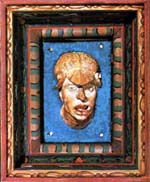Royal Audience
Hall
194 men and women of all
walks of life, from the commonalty to royalty, looked down
on the Polish King whenever he was receiving envoys or
holding debates of state or conducting trials in the Throne
Room of the Wawel Royal Castle. They are even said to have
been rebuking him at times. Which seems unthinkable since
their wooden heads thrust through the ceiling to merely form
interior decoration with no counterpart anywhere in the
world.
Nowadays just 30 of the
original 460-year-old sculptured heads can be still seen in
the Audience Hall (Sala Poselska), often called the
Hall Under Heads (Sala Pod Glowami). No doubt, the
masterly and realistic Wawel Heads depict people who lived
in the early l6th century when the Renaissance Royal Castle
was built in
Krakow for King Sigismund I the Old. Unfortunately, we
know neither why nor who was immortalized this strange way.
Some think the Wawel Heads bear features of the courtiers of
King Sigismund and his Italian wife Bona Sforza. Other
theory maintains they illustrate some literary work (perhaps
an ode for the royal wedding) much like Hans Durer's frieze
of 1532 in the same hall interprets the ancient Greek story
of the Life of Man by Kebes.

In November visitors can see the State Rooms and other
exhibitions at the Krakow Royal Castle free of charge.
The following are permanent
exhibitions on the Wawel Hill:
Royal Chambers - historical interiors,
tapestry collection of Sigismund II Augustus, royal portraits,
Italian Renaissance furniture, Italian and Dutch painting of the
14th to 17th century.
Royal Private Apartments - rooms where
the Polish royalty lived, period furniture and art.
Crown Treasury and Armory
- regalia, jewelry, precious weapons, armors and
caparisons; Polish and West European.
Oriental Art - Turkish tents
and banners, Turkish and Persian weapons and carpets, Chinese
and Japanese ceramics.
The Lost Wawel - archaeological
and architectural reserve of the early 11th-century church of
St. St. Felix and Adauctus' with surroundings; objects excavated
by archeologists on the Wawel Hill; ornate stove tiles of the
16th and 17th century. Plus multimedia presentation of the Wawel
Hill's history.
Dragon's Den - big
cave said to be the fiery monster's
hideout.
Visitors can also
see varied temporary exhibitions.
The
Wawel Hill is accessible to visitors
daily since April through September from 6.00 a.m. to 8.00 p.m.
and since October through March from 6.00 a.m. to 5.00 p.m. The Royal Castle's arcaded courtyard is off limits half an hour
before the closing time. Exhibitions in the Royal Castle are
closed on Christmas, New Year's Day, Easter Sunday, November 1
and November 11.
Admission terms
and fees might be subject to changes. For inquiries and booking
please contact the Tourist Service Office (BOT), Wawel 5, 31-001
Kraków, Poland, tel.: (+48 12) 4225155 ext. 291, tel./fax: (+48
12) 4221697
|
Krakow in Poland
Wawel Hill
Wawel Hill in Krakow, the mecca of every Pole and a
must for foreign tourists, is a microcosm of Polish history
and culture.
Wawel Cathedral
Poland's impressive national shrine shelters plenty of
superb church art.
Wawel Royal Castle
Home to three dynasties of Poland's monarchs. Its
stately halls and exquisite chambers are filled with priceless
art, best period furniture and rare ancient objects. The
collection of the 16th-century monumental Flemish tapestries is
matchless.
Arrases
The matchless collection of 16th-century monumental
Flemish tapestries.
Crown
Treasury and Armory
The Crown Treasury shows Polish royal memorabilia, jewels and
other precious items. The adjacent Armory displays 15th to
18th-century arms.
Dragon's Den
Huge natural cavity inside the Wawel Hill is the
legendary home of a legendary monster.
|
